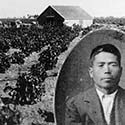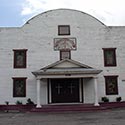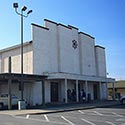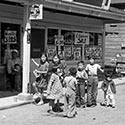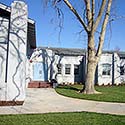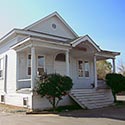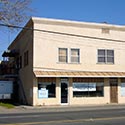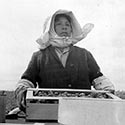 |
FlorinBeginning in the 1890s, Issei immigrants replaced Chinese laborers in the fields around Florin, which had been established along the railroad line about eight miles southwest of Sacramento. As farmers shifted from growing wheat and hay to more intensely cultivated strawberry fields and vineyards, the small town of Florin became one of the largest Nikkei agricultural settlements in California. By the 1910s, Japanese immigrants leased or owned over one thousand acres and Florin’s Nihonmachi overshadowed other areas of town. Their prominence became so pronounced that the small community drew national attention and emerged as a target for anti-Japanese political campaigns. Politicians journeyed the short distance from the state capital to see the "Japanese problem" first hand in Florin before passing the Alien Land Act of 1913, which restricted land ownership for "aliens ineligible for citizenship." A few years later the local school board segregated Florin’s elementary school. Despite these assaults, Florin’s Nihonmachi grew and served as the cultural, social and commercial center for Japanese farm families throughout the area. ›› CLICK TO ENLARGE.
PROFILES
| ||||

Japanese immigrants around Florin quickly made the transition from cultivating land as laborers to tenant farmers to leasing and owning land within a few short years after the first Issei arrived in the 1890s. Dwellings like the Takeokas' farmhouse depicted above were generally rough wooden structures built by the farmers themselves and sparsely furnished. During harvest time, farmhouses became boarding houses as temporary laborers found lodging with permanent residents. Japanese farmers planted strawberries between rows of grape vines, counting on the berries to provide a cash crop while the vineyards reached maturity. As production of both fruits grew, shipping companies formed to connect Nikkei farmers to local and national markets. In 1941, a record-breaking 130 railcars of Tokay grapes left Florin's Southern Pacific Station. Photo courtesy of California State University Sacramento.

In 1913, the Sacramento Bee complained that "Japanese controlled and owned the town of Florin" and that the school "built for the children of white men, is now almost half Japanese." The Bee's publisher, V.S. McClatchy, resigned his post to campaign more actively against Japanese presence in California and influenced legislation passed in 1921 allowing school districts to establish separate "Oriental Schools." Two years later, Florin built a new school for white students on the west side of town and this grammar school building became a segregated school, just as the towns of Walnut Grove, Isleton and Courtland established separate schools for Asian students. Many Nisei already attended all-Japanese language classes in the afternoons or on Saturdays. "Before we understood what had happened, said Florin resident Mary Tsukamototo, "Florin Grammar School became a segregated school. We were not aware that a new red brick school building was quietly being constructed by the parents of the white children." This discriminatory pattern held for 16 years until the Florin Japanese American Citizens League persuaded the school board to end the policy in 1939. The school complex was renovated in 2004 and now serves as a county-run therapeutic recreation center.

Florin's Japanese Methodist Church formed in 1913 and by 1916 had erected a house of worship with space for a language school. Churches were the center for social as well as religious life for Florin's Nikkei. This structure was built just one year after some of Florin's white residents built Redmen's Hall, which still stands a short distance away. Japanese, not allowed to join the local Grange or fraternal associations such as the Redmen, would have been excluded from dances and social gatherings at the Hall. The Methodist church building's second floor held activities of several groups including the women's Epworth League and the Christian Seinen Kai (Youth Association). A second church structure and a dedicated Japanese school building were built by the congregation on the same Florin Road property prior to WWII, leaving the original structure to serve as the Methodist Social Hall. While the language school is gone, the other buildings still stand and are in use as church facilities by the local Tongan community.

Florin's still active Buddhist Church complex holds structures spanning seventy years of community life. The Florin Investment Company was formed in 1919 to hold title to 2.5 acres purchased for a Buddhist Church, which had been incorporated the previous year. The men on the church board and newly organized Fujinkai (women's organization) shepherded construction of the church and its dedication on March 21, 1921. An affiliated Japanese school began the same year and in 1925 a Gakuen Hall was dedicated to provide space for teaching Japanese language skills and as a social hall. A large gymnasium and social hall were added in 1939. These building served as hostels for Nikkei who returned to the area after the war. A new church facing adjacent Prichard Road was dedicated in 1976. Although the language school building has been demolished, the gymnasium is still in use by the sangha, which leases the original church structure for kendo and karate groups.

The Buddhist Church's robust youth program led to the development of a massive Young Buddhist Association gym and hall directly behind the church. The Methodist church also offered Florin youth, both girls and boys, opportunities to be active in sports including basketball and baseball teams that competed regionally. The YBA Hall was in service for only two years before WWII evacuation transformed it and the other church structures into storage space for household goods and personal belongings of those interned.

Japanese-owned stores began flourishing in Florin as the town served the commercial needs of farmers in outlying areas. By 1913, the community boasted four general stores, two barbershops, and a pool hall and ice cream parlor. Just prior to WWII, Florin's Japantown had added the Akiyama Fish and Grocery store, Nakayama Shoe Shop, the Tsuzaki Garage and Sasaki Tofu Shop. Two midwife practices were listed in Florin. Longtime area resident and Florin JACL member, Bob Uyeyema, helped with our survey of historic resources and found only two extant structures that reflect Florin's pre-WWII Japanese American businesses, the Ogata Store and H. Kato Grocery and Fish Market.

By 1940, over 1,600 Japanese Americans lived in the area around Florin. Over two-thirds of this population were American-born and therefore U.S. citizens. This image was taken by Dorothea Lange two days before all Nikkei residents were evacuated from the area under Executive Order 9066. Unlike most Japantowns, whose residents were sent to the same assembly centers and relocation camps, Florin's community was separated into four groups defined by the railroad tracks and Florin Road and sent to different destinations. Nikkei businesses like this fish market were sold, leased, or left vacant. In 1944, a fire roared through part of Florin's Nihonmachi, destroying nine buildings, including a warehouse that held the furniture and personal belongings of several families. Florin never regained its Japantown or its prominence in Northern California agriculture after World War II. Photo courtesy of Bancroft Library.

Women often provided the stoop labor for picking Florin's abundant strawberry crop, which, like grapes, were packed in baskets produced by Nikkei-owned factories such as Nishi Basket and Capital Basket Company. Local farmers prospered as packing and shipping companies developed to move Florin produce via rail to other parts of the United States. As early as 1902, freight trains carried strawberries from Florin to customers in the Midwest. Japanese-owned shippers such as the Northern California Berry Grower's Association, Florin Berry Company and the Florin Fruit Exchange were an important component of this supply chain. These shippers also played a crucial role by making loans to Japanese farmers that helped many families make ends meet during lean seasons. Photo courtesy of Bancroft Library.
